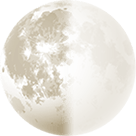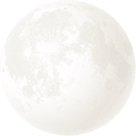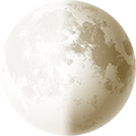What's in the night sky in April (2023)What to see in April's night sky including Moon phases, planet guide, conjunctions, the Lyrid meteor shower and Deep Space Objects M3, M108 and M97.
April Moon Phases
Northern Native Americans call April's full moon the pink moon after a species of early blooming wildflower. In other cultures, this moon is called the sprouting grass moon, the egg moon, and the fish moon.
Full Moon and New Moon for April 2023

April 2023 Last QuarterThu 1st Jan

April 2023 Full MoonThu 6th Apr

April 2023 New MoonThu 20th Apr

April 2023 First QuarterFri 28th Apr
April Planets
Mercury is impressive in the evenings, setting at least 2 hours after sunset by the end of April. It reaches its greatest Eastern elongation on April 11th and will be visible around 30 minutes after sunset. It's not particularly bright, nor is it going to be close to any bright stars or planets to aid location.
Venus is always brilliant, shining with a steady, silvery light. Mornings in the eastern sky at dawn from early January through to mid-June. On the 10/11th Venus will pass 2.6 degrees from the Pleiades star cluster.
Mars is visible in the night sky from January to mid-July, then shifts to the morning sky from mid-Oct to the end of December.
Jupiter is in conjunction with the Sun in April so will not be visible.
On April 30th Jupiter and Venus will be at their closest approach and visible in the same low-powered telescopic field of view.
Saturn is visible in the mornings but it is not well placed and observation is less than ideal.
April Hybrid Solar Eclipse
There will be a hybrid solar eclipse on April 20th. The eclipse path will begin in the southern Indian Ocean and move across parts of western Australia and southern Indonesia.
A Hybrid Solar Eclipse is a rare event where both a regular total solar eclipse and an annular eclipse are visible, depending upon your location along the path of totality.
April Meteor Showers
The Lyrids is an average shower, usually producing about 20 meteors per hour at its peak. It is produced by dust particles left behind by comet C/1861 G1 Thatcher, which was discovered in 1861. The shower runs annually from April 16-25. It peaks this year on the night of the 22nd and the morning of the 23rd. The 2023 Lyrids could be a good show as there is a new Moon and darker skies. Under ideal conditions, there should be around 18 meteors per hour. Meteors will radiate from the constellation Lyra, but can appear anywhere in the sky.

April Deep Space Objects
The spring night skies are home to some wonderful globular clusters. M3 in Canes Venatici and M5 in Serpens are good targets for a small telescope and can also be glimpsed with binoculars from sites with dark skies.
Surfboard Galaxy (M108) is a barred spiral galaxy in Ursa Major. Even though it appears almost edge-on, M108 is a popular target among amateur astronomers and astrophotographers because details of its structure can be seen even in amateur telescopes. 3-inch telescopes will only reveal an elongated streak of light with a brighter core, while 8-inch instruments will hint at the galaxy's dusty regions and bright and faint patches.

The Owl Nebula (M97), is another famous object in Ursa Major. A planetary nebula forms when a dying Sun-like star ran out of hydrogen fuel, collapsed from a red giant to a white dwarf, and ejected its outer envelope. The expelled material is now heated by the radiation of the central white dwarf, producing the nebula's glow.
Also in Ursa Major, Bode's Galaxy (M81) and the Cigar Galaxy (M82) are a nice bright pair to track down.









